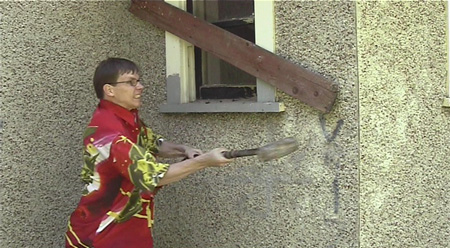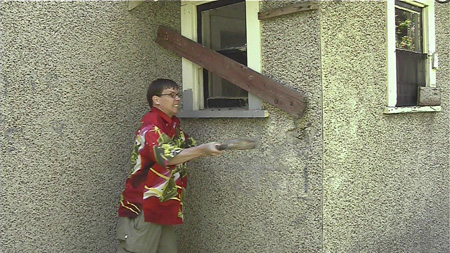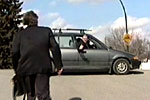
JVC GR-HD1 Review
Today’s review comes in two flavors.. Old school text (keep reading for the full experience), or a video review! (I guess it’s almost like a podcast but way more virtual reality matrix blade runner styles)
The GR-HD1’s core capability: 1280x480x30p video capture. While certainly preferable over any form of DV, the camera’s HD mode does suffer from artifacting. These artifacts can be reduced by improving the lighting conditions, but I am unable to eliminate them entirely.
I would suspect they are created during MPEG-2 compression, due to an insufficient bitrate. I can actually hear the camera change speed when playing back DV footage, compared to SD and HD footage. Reviewing file sizes of the different captures shows that DV is taking more space per second then SD and HD formats.
Now, I’m not looking for trouble. I can understand JVC not wanting to re-invent the wheel, and limit the HD-GR1’s data rate to 3.6 MB/sec like DV uses. Its probably a bitch to try record data at a higher rate onto a miniDV tape. You might have to spin the tape faster, alter the tape mechanism… hell, I couldn’t do it.
But why, God, why, would you compress MPEG-2 footage to a data rate LOWER then DV? Granted, MPEG-2 is a much better compression algorithm then DV, but if you’ve got artifacts, and you’ve got bandwidth to spare…
Data streams:
- DV (image size 10 MegaPixels/sec) gets data rate of 3.6 MB/sec (sample)
- SD (image size 20 MegaPixels/sec) gets data rate of 2.4 MB/sec (sample)
- HD (image size 28 MegaPixels/sec) gets data rate of 2.4 MB/sec (sample)
- It gobbles power. The 2800mAh battery it came is only good for about 3 hours usage. Specs say it uses 8 watts while using viewfinder.
- 10x Optical Zoom.
- Same Firewire 1394 port is used to relay SD and HD MPEG-2 data to PC as is DV data.
- F1.8 lens, f=5.2mm to 52mm, 52mm filter diameter.
- Uses optical image stabilization.
- Maximum shutter speed: 1/1000sec.
- MPEG Edit Studio LE
- ImageMixer DVD
Perhaps this is why SD hardly shows any artifacts, but HD often does. They’re trying to stuff almost 1/3rd more picture information into the HD data stream as the SD data stream. Why didn’t they simply up the HD data rate to 3.6 MB/sec?

SD Frame

HD Frame
HD-GR1 also requires an amazing amount of light. Specs state 35 Lux minimum illumination. The less light, the more video noise. More video noise means more MPEG-2 artifacts. Even natural light at dusk seems stingy for this camera.
Here are some other observations:
According to JVC, the HD-GR1 uses a patented “Hybrid Complementary-Primary Color Filter” which “delivers maximum resolution with color performance nearly identical to using three CCDs”. Thou I did detect noise in color when cranking up the saturation in post production, this was minimal in SD mode where MPEG-2 data compression is least likely to introduce artifacts. I believe JVC’s CCD does a great job of capturing color detail.

Still of CCD
Audio input is a minijack, which I don’t mind but might make those with professional audio gear consider the professional JY-HD10 model. In HD and SD modes, audio is compressed to 384kbps (48kHz). Pickup of camera noise is minimal, thou in most circumstances you’ll still want an external mic.
There is an electronically driven focus and zoom ring. Autofocus seemed a bit less stable then I’ve been used to with modern camcorders, so I’ve found myself switching to manual focus more frequently. While the flip-out LCD display at the side of the camera is fine for lining up a shot, I’m not sure how I’m expected to manually focus a shot. Its not like the 200,000 pixel LCD is skimpy, it still common to find camcorder LCD displays with only 100,000 pixels. But the LCD’s resolution is way too low for focusing a 1280×720 picture.
Often I’d zoom in on an item, set up focus, zoom out and roll the camera, but still be uncertain if the shot was really in focus as would do HD justice. I think JVC could have offered a button on the LCD to digitally zoom in (so LCD was showing 1:1 resolution) on the middle of the frame, to assist with focus. I expect people normally have an external monitor hooked up to assist with focusing, but for me that’s not always an option. Focus was never an issue with DV, but between the GR-HD1’s appetite for light shortening the range of focus, and HD’s high resolution I find myself spending way too much time worrying about focus.

A camera with such a digital-zoom-to-focus feature is Sony HDR-FX1, a $3,700 USD 1080i 3 chip model. The Sony camera also generates zebra pattern to help avoid over exposure, another feature I would have appreciated on my camera. Between focus and exposure, I’m never 100% what I’ve captured until I’ve had a chance to review it on something besides the camera’s built in LCD.
One very handy feature is the camera’s ability to record digital stills (up to 1280×960) onto an SD Memory Card. To do so requires switching the camera from DV, SD or HD mode and setting it to “memory” mode. The camera can also take 5 seconds “stills” when in its various video modes, but I don’t see any utility in that. I would have preferred the “photo” button be used solely for memory card capture, so the camera’s state would not have to be changed to capture stills into memory.
Once your HD footage is captured, there are 2 things you can do with it: Hook up the GR-HD1 to an HDTV using proprietary component cables (supplied with camera). Or use an 1394/Firewire cable to transfer the MPEG-2 data onto your PC. The software which ships with the camera only supports PCs, thou I’ve seen posts directing Mac users to… http://developer.apple.com/firewire/ ..my experience on a brand new iMac has been flawless. iMovie recognized the HD camera, no special software needed. Most impressive.
While the bundled (PC) capture software is nice enough to split the raw data stream into segments when ever the time code skips ahead, it is still a surprisingly weak tool. There is no way to disable this file splitting (maybe I want a crazy huge file, huh?). Nor is there a [Capture Entire Tape] button. Rewind… then start recording… how hard could that be. And there is no automatic spill-over when your target drive is full. How about listing 3 drives in order of preference? How about remembering where I saved files to last time? How about some love?

The camera takes 52mm filters and lenses. Both Sony and JVC sell appropriate lenses (thou sometimes adapter rings are needed). I picked up a Sony VCL-MHG07 0.7x wide-angle lens. This wide-angle lens screws in directly to the JVC’s 52mm threads which is handy as an adapter ring is just another part to lose when you’re in a hurry. 0.7x really helps when you’re trying to shoot on-the-fly and not worry so much about focusing and lining everything up into a shot.
Manual exposure control required digging out the manual, but it makes sense once you’ve done it. It wasn’t very “numbers based” thou. Everything is relative to the current brightness the camera is experiencing. So, say in a bright room, once you have your exposure and iris locked, you CAN enter a darker room and that room will remain dark, as opposed to the camera compensating for you and brightening up the room again. BUT once you are in that dark room, there is no way to save your exposure settings. Turning the camera off and on (switching battery) starts you over. You can leave the darker room, perform the exact same steps in the brighter room, and you should end up with the same settings. But if you can’t leave the dark room, you can only approximate what the settings were before.
GR-HD1’s bundled software included
..neither of which I tried. I can verify thou that After Effects 6.5 and Vegas 6.0 both accept the HD MPEG-2 footage. After Effects requires that the files be renamed from their default .m2t to .mpg, or that Windows be configured so that .m2t files are recognized as MPEG-2 data.
Overall, my experience with the camera has been a positive one. I have no desire to shoot in DV ever again. The HD MPEG-2 artifacts are annoying and dissapointing, but ultimately I’m still getting much more picture detail to work with. SD mode is a lot of fun, and I’m looking forward to recording the destruction of many objects with it.
But then your needs might be quite different from mine. I create entertainment and corporate videos. The only computer that needs to understand my footage is my own. Without the proper codecs, you can’t just drop HD footage onto a PC and be sure it will play. Even CPU power becomes a major concern when simply trying to play back smooth HD footage. My 2.6GHz system chugs along pathetically as I edit in Vegas.
I don’t even own an HDTV. Thou if I did, I’d be either playing my HD footage back using an HD Video Out card on my PC, or by exporting the footage out to my camera and playing THAT back out to the HDTV. For now, I show up at my brother’s. He own owns a fine 34″ HDTV. I ring the doorbell, my anamorphic DVD in hand, and ask the question, “Oh did I wake you again?”
So far, my creations aren’t HD. I tape in HD. Use it as source footage when I’m making 720×480 (anamorphic) 16:9 MPEG-2 finished product. The anamorphic video can then be played back on any progressive scan DVD to give slightly cleaner picture when viewed on an HDTV.
Is THAT worth $1700 USD? To create anamorphic DVDs which give slightly sharper picture? Well, as I stated at the start of this article, shooting in anamorphic DV will already get you THAT. Thou I do plan on HD end products in the future, the benefit to me is of improved workflow and footage flexibility.
Re-cropping shots in post production. Slowing down footage. Boosting chroma levels. Blue screening. The quality of pretty much every post production effect is enhanced by HD footage. If you’re not doing any effects, and use footage pretty much exactly as shot, then your benefit from a camera like this might be minimal.
JVC GR-HD1 is like a Russian mail order bride. Unless you have very peculiar needs, or can get one second hand at half price, you might be better off sticking with your old ball and chain.
Have you read Gords other article this month “Why might I need an HD Camera?”

- JVC GR-HD1 Review
- by Gordon McDowell
- Published on July 1st, 2005
More from Gordon McDowell:
-

R4NT Video: 10 Cents
Gordon McDowell and Geoff Helmer take the reigns and herein have spurred some heated discussion on borrowing.
-

Brownie points with Slumdog Millionaire
That's what your woman has really been craving every time she goes to see a chick flick, but she doesn't know it. In fact it is scientifically impossible for a woman NOT to watch the Slumdog Millionaire end credits and not feel deeply satisfied.
-

JVC GR-HD1 Review
I would suspect they are created during MPEG-2 compression, due to an insufficient bitrate. I can actually hear the camera change speed when playing back DV footage, compared to SD and HD footage.
-

Pontypool – Telefilm Grant Inspires a Wave of Terror
Since Danny Boyle’s “28 Days Later”, the zombie movie has seen a constant injection of fresh ideas. Pontypool carries the baton still further.
-

Comedy of Allyson Smith
The performance was hilarious each time, but also tuned to different levels of filthiness. Sadly, Allyson’s “It goes to eleven” moments can’t be represented on YouTube, lest the Internet’s pristine reputation become sullied.
-

Why I wish I was back in School
If students need to research background information, student resources are available on the web, including the student drug fact sheets, Lowdown About Marijuana and Lowdown About Inhalants.
Other recent features:
-

Sónar 2010 – Barcelona, Spain
The festival attracts a lot of outsiders, but the Mediterranean, Spanish and more specifically Catalan nature of the people makes the festival what it is. Catalan people are passionate and this passion is infectious. The atmosphere is electric in Barcelona as a city and heightened by music and intoxicants at Sónar.
-

Summer Party Naval Styles at Seven RestoLounge
Oysters, like wine are affected by terroir and these Miyagi’s flavor profiles ranged with one showing a cleaner, almost tropical profile and the other being more salty, marine driven. As I was devouring the seemingly endless plates put in front of us, I sipped on a glass of fine sauvignon blanc.
-

R4NT Radio March 2010
R4NT Radio March 2010 um wow it’s been far too long since the last edition edition, featuring: Hector Hernandez, The Infesticons, Blockhead, Gramatik, Emika, Thunderheist, Parov Stelar, Eddy Meets Yannah, Anti-Pop Consortium, The Slew, Lighterthief, Andreya Triana, Parasyte Woman, Mathon, Venetian Snares, and Funki Porcini.
-

O Restaurant & Lounge revisited
Calgary has a diverse set of urban communities, most of which have the ubiquitous strip mall watering hole. In the South West community of Marda Loop, a reinvention of this paradigm has been established.
-

Predictions 2010.. and beyond!
So 2010 eh? Almost but not quite (no year zero they say) another decade? It seems like just yesterday that the world was waiting for Y2K. R4NT started publishing in March 2001, so we’re not quite 10 years old yet, but in internet years we are already a senior citizen.
-

Invictus
No matter what, the reality of Nelson Mandela is something that deserves screen time. Should this film even remotely intrigue the masses to take interest in this figure, the world would likely benefit greatly from it.




